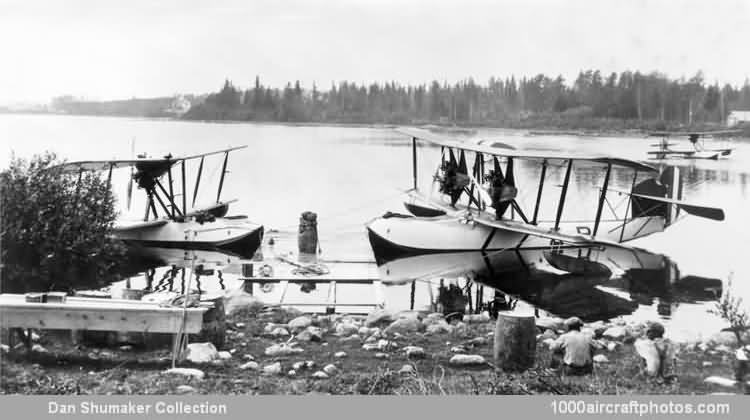Performance was specified as a maximum speed of not less than 95 mph (153 kmh), an absolute ceiling of at least 14,000 ft (4,267 m), and a maximum alighting speed of 45 mph (72 kmh). Although not specified, another source indicates that the RCAF was hoping for an initial rate of climb of about 750 ft (229 m)/min.
To meet this requirement Canadian Vickers designed an unequal-span biplane flying boat which may be described as an enlarged Vedette with wings of USA 27 section. The hull structure was the same as the Vedette's and a welded steel tubular structure was also used for the tail surfaces. The upper wing was made in three pieces consisting of a center section with steel-tube spars and wooden ribs and two outer panels with an all-wood structure which were interchangeable with lower outer panels. The lower wing was made in four pieces with a stub wing using steel spars on each side of the hull and the two outer panels.
The prototype, Varuna Mk.I, G-CYGV c/n CV 30, was first flown by Squadron Leader W.R. Kenny from the St. Lawrence river at the Canadian Vickers plant on October 22, 1925. It was shortly flown to Rockcliffe where trials continued, with most of the flying being done by Flight Lieutenant R.S. 'Bill' Grandy, and was officially taken on strength by the RCAF on June 2, 1926. The Varuna Mk.I must have met the RCAF requirements, for a new specification for the production Varuna Mk.IIs was drawn up and seven were ordered, three in October and four more in December 1926. These were delivered in the spring and summer of 1927.
The new specification, C/3/26, requested changes from the original requirements. The engines were now to be 180 hp Armstrong Siddeley Lynx IVs (to comply with RCAF policy to standardize on the Lynx engine during this period), the lower wing was to be raised a minimum of 9 in (0.23 m), the center section cockpit was now to accommodate two men as was the rear cockpit, slightly larger wing tip floats were specified, and Canadian Vickers was asked to experiment with the prototype in order to reduce the amount of spray thrown into the propellers.
Subsequently an addendum was issued noting that the fuel tanks, located within the wing over the engines in the Varuna Mk.I, were considered to be a fire hazard and were to be moved to the center section and located on each side of the aircraft center line; also, it was mentioned that it was permissible to fit them outside the wing contour instead of within it as on the Varuna Mk.I.
Trials of the Varuna Mk.II showed that the forward hull lines had been improved and the hull now ran very cleanly and left the water easily, as had the Varuna Mk.I; in all other respects the Varuna Mk.IIs performance had deteriorated. This was not surprising as the power had been reduced, and almost all of the changes requested by the RCAF had increased the drag or reduced the lift or both. Still, the changes were carried out to RCAF requirements and the Varuna Mk.IIs were accepted.
The Varuna Mk.IIs spent most of their working lives in the Province of Manitoba, although G-CYZV crashed at Fredericton, New Brunswick, on November 9, 1927, while stationed at Dartmouth Air Station in Nova Scotia. Their poor performance restricted them to flying only from large bodies of water and conŽtinued to plague their crews until the end of their careers, and while their actual take off was not complained of, once airborne their climb and speed was very poor. Performance deteriorated with time as the wooden hulls soaked up water.
A new specification, C/3/27, was issued in June 1927 for a Varuna Mk.III flying boat which was to be like the Varuna Mk.II except for the substitution of a metal hull. But it was soon realized that what was needed was a larger and more powerful machine, and a further specification, C/5/27, was prepared which resulted in the Vancouver. All Varuna Mk.IIs were struck off strength by the end of 1930 and the single Varuna Mk.I, which had served at Rockcliffe, was put into storage at that time and struck off strength in 1932.
G-CYZR was delivered June 13, 1927. The aircraft to the left and in the background are Vedette's."
|
|
Varuna Mk.I |
Varuna Mk.II |
